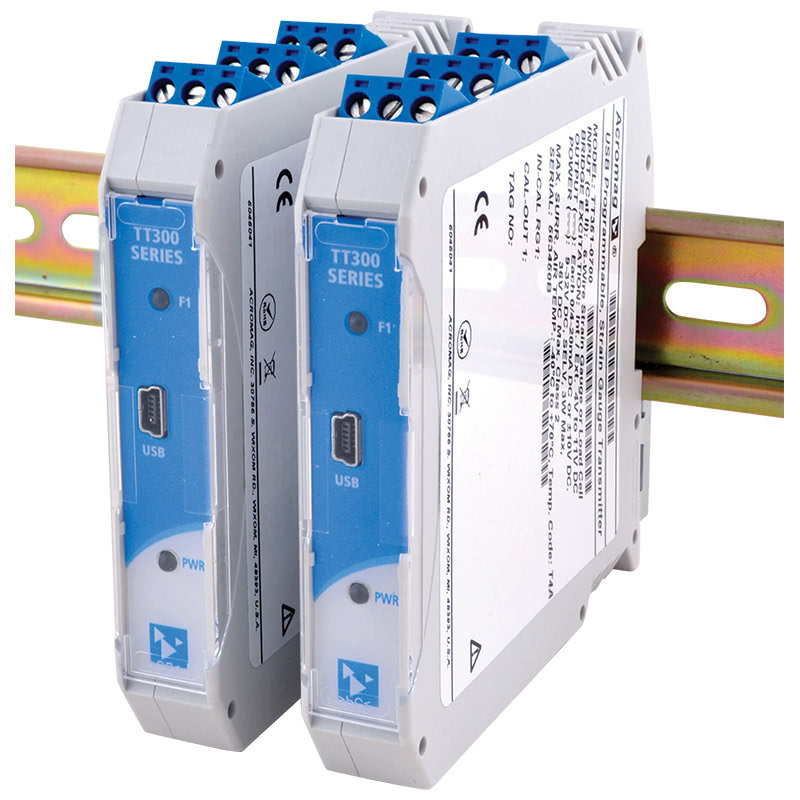The TT351 model are compact millivolt, strain gauge and load cell signal transmitters. They take signals from four or six wire strain gauge bridges, load cells, or millivolt sensors and process and convert them into isolated voltage (0-10V) or current (4-20mA) output signals.
What is their purpose?
Therefore, their purpose is acting as a bridge between sensors and other equipment. The four-wire configuration of the transmitter ensures proper communication to the sensors. Which in turn provides, accurate, isolated signal converted outputs for further processing or transmission.
Features Load Cell Bridge & Strain Gauge Input Transmitter
- Inputs – Load Cell, 2 x ¼ Bridge Options, 2 x ½ Bridge Options, 3 x Full Bridge Options, Millivolt Bridge
- Universal Output supports 6 Ranges – 4-20mA, 0-10V, +/-10V
- Separate Current & Voltage Output Terminals
- User Specified Input over range limiting
- Differential Input provides true ratio-metric conversions with measurements that remain accurate over time and temperature
- Initial Bridge offsets auto removed with null compensation/zero balance of bridge functions
- With this powerful hardware and software combination plus a low competitive price
- Remote Sense and Measurement of Bridge Excitation
The TT351 is 17.5mm wide and operates in extreme temperatures from -40° to 70°C. Tested for shock up to 25g and vibration up to 4g resistance. The TT350 Series is CE Certified and has Hazardous location approvals such as UL508, UL/cUL Class 1 Div 2 and ATEX/IECEx Zone 2.
Due to the high accuracy, linearity, reliability and stability of this product range. It is regularly used in applications such a raw material processing, factory automation, test and measurement, transportation and also by food, beverage and pharmaceutical manufacturers.
Reasons why you should consider them for your Signal Conversion Application
Enhanced Performance:
The Acromag TT351 offers high accuracy, precision, and reliability. Firstly, it features an excellent signal-to-noise ratio, and wide bandwidth to ensure optimal signal conversion and integrity. Optional DIN Rail bus can deliver primary or redundant power to multiple units.
Compatible with Various Signal Types, Input Ranges, Output Formats:
Transmitters are versatile and compatible with various signal types, input ranges, and output formats. Such as flexible Strain Gauge Bridge, Load Cell or MilliVolt Inputs. Along with outputs of 0-20mA, 4-20mA current and 0-5V, ±5V, 0-10V and ±10V ranges.
Advanced Signal Conditioning Capabilities:
Our signal converters have advanced signal conditioning features, such as filtering, amplification, linearisation, and isolation. This improves signal quality, compensates for environmental influences, and enhances the accuracy of the converted signals.
Ease of Use and Configuration with USB Connection:
This product provides an easy set up and calibration via USB to ensure seamless integration into existing systems. Acromag Agility™ App is free software. Available for Windows or Android. It enables users to easily configure the product to their requirements. The software has powerful signal conditioning capability with precise conversion of bridge inputs to process current or voltage control signals.
Operates in Extreme temperatures:
The TT351 operates in temperatures from -40° to 70° and is housed in NEMA Type 1 Enclosure, that is suitable for DIN Rail Mounting. Along with Shock (25g) and Vibration (4g) immunity.
Approval Certifications
This Signal Conditioner Unit features: CE, UL/cUL class 1 division 2 groups ABCD compliance. Along with ATEX or IECEx Zone 2.
Local Support:
Metromatics provide local technical sales and support for the Acromag product line to our customers in Australia and New Zealand.
Finally, for more information on this load cell and bridge strain gauge input transmitters, contact us.
In addition, check out this White Paper written by Acromag on Introduction to Strain & Strain Gauge Measurement. A really useful resource.
